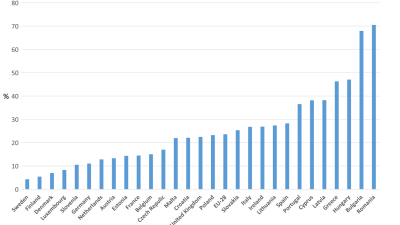Direct measures of poverty that look at deprivation and living standards have a very long history, particularly in Britain. From Charles Booth and before, through to Seebholm Rowntree and Peter Townsend in the twentieth century, the living conditions of the poor have been investigated to establish those who live in poverty.
Peter Townsend, in particular, pioneered a relative deprivation approach to poverty that covered a wide range of aspects of living standards, both material and social. For Townsend:
Individuals, families and groups in the population can be said to be in poverty when they lack the resources to obtain the types of diet, participate in the activities, and have the living conditions and amenities which are customary, or at least widely encouraged or approved, in the societies to which they belong. Their resources are so seriously below those commanded by the average individual or family that they are, in effect, excluded from ordinary patterns, customs and activities.
(Townsend, 1979)
Measures of deprivation are not the same as measures of income – they relate to how people live. Deprivation is the consequence of a lack of income and other resources, which cumulatively can be seen as living in poverty. The relative deprivation approach to poverty examines the indicators of deprivation, which are then related back to income levels and resources.
To further this relative deprivation approach, Townsend developed a list of sixty indicators of the population’s ‘style of living’ for a survey into standards of living in the United Kingdom carried out in 1968/69. The indicators were built up from items covering:
- diet
- clothing
- fuel and light
- home amenities
- housing and housing facilities
- the immediate environment of the home
- the general conditions and security of work
- family support
- recreation
- education
- health
- social relations.
A lack of or non-participation in these indicators was seen as an indicator of deprivation. A ‘score’ for different forms of deprivation could be ascertained and related to household income.
This research was reported in Poverty in the United Kingdom (Townsend, 1979) and a key finding was that there were levels of income below which consumption and participation fell well below what might be seen as normal or acceptable in an increasingly affluent society. It was this group that was seen to be in poverty.
Critics of this approach argued that the indicators of deprivation were arbitrary and that, by measuring indicators of deprivation, the methodology failed to allow for difference and choice in how people live. The consensual method set out a new approach aimed at tackling these criticisms.
References
Townsend, P. (1979) Poverty in the United Kingdom, London, Allen Lane and Penguin Books.
Last updated: 21 January, 2016



 PSE:UK is a major collaboration between the University of Bristol, Heriot-Watt University, The Open University, Queen's University Belfast, University of Glasgow and the University of York working with the National Centre for Social Research and the Northern Ireland Statistics and Research Agency. ESRC Grant RES-060-25-0052.
PSE:UK is a major collaboration between the University of Bristol, Heriot-Watt University, The Open University, Queen's University Belfast, University of Glasgow and the University of York working with the National Centre for Social Research and the Northern Ireland Statistics and Research Agency. ESRC Grant RES-060-25-0052.






